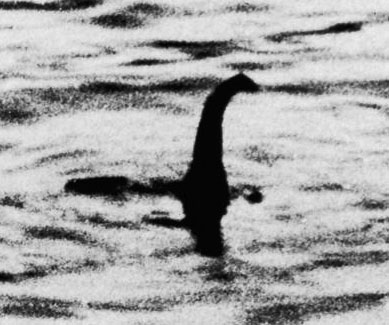
The term Loch Ness Monster or Nessie refers to a supposed creature or family of creatures believed to inhabit the Scottish lake Loch Ness.
The "monster" has been sighted hundreds of times throughout the centuries, and has been the subject of serious scientific investigation. At this point, with no conclusive proof, the Loch Ness Monster remains a creature of popular culture and myth.
Learn about the famous Surgeon's Photograph, long-held to be almost definitive proof of a monster but now known to be a clever hoax that spanned decades and elicited a death-bed confession.
Explore a variety of Loch Ness Myths, including things that modern science can shed light on about Nessie.
A list of Books about the Loch Ness Monster and other aspects of cryptozoology.
Perhaps the earliest sighting, and the most well-documented (if not a bit fantastical-sounding) was the experience Saint Columba had with the Loch Ness Monster. Supposedly a gentleman had been swimming in the loch, when he was attacked by a savage water beastie. Saint Columba banished it back to the depths, where it has remained.
Sightings of the Loch Ness Monster began in earnest in the 1930's. This could be for a number of reasons. Population density was increasing in the area. There were a number of earthquakes that may have disturbed the creatures. A lot of road work and dynamite blasting was going on, which also may have disturbed the creatures or at least piqued their curiosity. And since there were so many road workers in the area, the loch was being watched constantly with more eyes than ever before.
Some say yes. A creature near Loch Ness has been sighted on the roadside near Loch Ness. There have been reports of horse-like monsters, hairy monsters, seal-like monsters, and even dinosaur-like monsters crossing the road, or simply resting in the shallower waters near the loch.
One of the hotbeds of Nessie sightings are in Urquhart Bay. There's a giant, photogenic castle on the loch, and many sightings occur there, particularly when the weather is clear and the water is completely flat and calm.
Several scientific explorations have been done, most notably by scientists such as Tim Dinsdale and Roy P. Mackal. Sonar efforts have been made (explained later in the page), underwater cameras have been set (with interesting results sometimes), and lots of pictures and video have been captured and analyzed. There have even been efforts to collect DNA from the creatures from boats or other areas where it's been sighted. Unfortunately, none of these efforts have been conclusive yet, but several have turned up enough evidence or enough possibilities to keep going as long as funding can be secured.
The geography of Loch Ness make it both difficult to study and optimal for hiding a rare or forgotten creature. For one thing, the Loch has very strange temperature patterns that make it ideal for many types of sea life and mammals. There's also an abundance of carp and other fish, more than enough to support a thriving colony of large animals. Also, there's possibly underwater tunnels between the loch and the surrounding lakes and oceans. Finally, the water is very murky, colored with peat from the mountain, and it's hard to see more than just a few inches into it. Also of significance is the amazing depth of the loch, going more than 700 feet in places!
One of the prevailing theories, that the Loch Ness Monster is a plesiosaur, is unlikely because of how the monster supposedly holds his head above water. A plesiosaurs could never hold his head like that... his head and neck stretch downwards, which makes it easier for eating fish or eating something off the bottom. Some think that the Loch Ness monster is actually a mammal of some sort, which would explain the hundreds of "blobs" on the surface that people have spotted throughout history... they would simply be the monster "surfacing for air". One common theory is that the monster is simply a giant eel or a misidentified otter or something native and commonly known to the loch. And still, one of the theories is that there's nothing there at all, and it's a case of mass hallucination and/or a publicity stunt.
Sadly, the most famous photograph of Nessie, the Surgeon's Photo, was faked. He made a little monster out of a toy submarine and some clay, and for decades, people used it as the definitive Loch Ness Monster photograph. There are, however, dozens of pictures and even videos that can't be explained, and until proven otherwise, may be evidence of a genuine Loch Ness Monster.
Several sonar sweeps have been done of the loch, intended to find evidence of large creatures moving underneath the surface. Some have shown evidence that there probably isn't something there, and some have shown evidence that there probably is something there. It's all inconclusive, however, because of various factors, mainly the depth and underwater anatomy of the loch, the possibility of sea tunnels, the possibility that the creatures aren't very active, and various other things. It's difficult to prove either position.